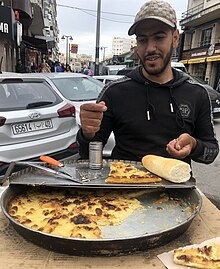
Caliente, also known as Karantika, is a street food eaten in Morocco and Algeria. It is a savory pie made from chickpea flour [1] and can include oil, eggs, spices, pepper, and cheese. It is typically sold by the slice by food vendors.
The name of the dish comes from the Spanish term calentito, meaning hot. [2]
The recognized origins of this street food would go back to Moroccans of Jewish faith in the city of Tangier, others associate it with the large Spanish community at the time. [3]
A variation of this street food exists in the city of Oujda where it is called “karan”. [4]
A similar dish exists in Gibraltar. Flavored with paprika, it has been described as one of the culinary symbols of Gibraltar by Hélène Jawhara Piñer. [5]
- ^ Moréno, Amédée (1995). Le parler d'Oran & d'Oranie: mémento-lexique, avec anecdotes, histoires & souvenirs de là-bas (in French). Editions J. Gandini. p. 65. ISBN 978-2-906431-22-5.
- ^ Dimech, Pierre (2009). Les écrivains algérianistes et leurs modèles: une petite anthologie de la vie quotidienne des Français d'Algérie des années 1890 aux années 1930-- (in French). Atelier Fol'fer. p. 40. ISBN 978-2-35791-008-9.
- ^ "La Calienté, la spécialité tangéroise qu'on savoure le jour de Aid El Mawlid - Plurielle". www.plurielle.ma/ (in French). 2019-07-16. Retrieved 2024-01-08.
- ^ Yabiladi.com. "Street food #3 : Le Karan, un plat de l'Oriental à la capitale". www.yabiladi.com (in French). Retrieved 2024-01-08.
- ^ Piñer, Hélène Jawhara (2021-06-15). Sephardi: Cooking the History. Recipes of the Jews of Spain and the Diaspora, from the 13th Century to Today. Academic Studies Press. ISBN 978-1-64469-533-3.

Caliente, also known as Karantika, is a street food eaten in Morocco and Algeria. It is a savory pie made from chickpea flour [1] and can include oil, eggs, spices, pepper, and cheese. It is typically sold by the slice by food vendors.
The name of the dish comes from the Spanish term calentito, meaning hot. [2]
The recognized origins of this street food would go back to Moroccans of Jewish faith in the city of Tangier, others associate it with the large Spanish community at the time. [3]
A variation of this street food exists in the city of Oujda where it is called “karan”. [4]
A similar dish exists in Gibraltar. Flavored with paprika, it has been described as one of the culinary symbols of Gibraltar by Hélène Jawhara Piñer. [5]
- ^ Moréno, Amédée (1995). Le parler d'Oran & d'Oranie: mémento-lexique, avec anecdotes, histoires & souvenirs de là-bas (in French). Editions J. Gandini. p. 65. ISBN 978-2-906431-22-5.
- ^ Dimech, Pierre (2009). Les écrivains algérianistes et leurs modèles: une petite anthologie de la vie quotidienne des Français d'Algérie des années 1890 aux années 1930-- (in French). Atelier Fol'fer. p. 40. ISBN 978-2-35791-008-9.
- ^ "La Calienté, la spécialité tangéroise qu'on savoure le jour de Aid El Mawlid - Plurielle". www.plurielle.ma/ (in French). 2019-07-16. Retrieved 2024-01-08.
- ^ Yabiladi.com. "Street food #3 : Le Karan, un plat de l'Oriental à la capitale". www.yabiladi.com (in French). Retrieved 2024-01-08.
- ^ Piñer, Hélène Jawhara (2021-06-15). Sephardi: Cooking the History. Recipes of the Jews of Spain and the Diaspora, from the 13th Century to Today. Academic Studies Press. ISBN 978-1-64469-533-3.